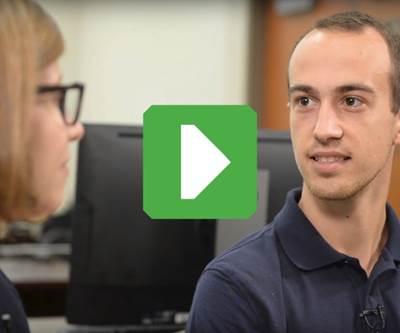The Challenges of Teaching Creativity in Additive Manufacturing
The extensive design freedoms offered in additive manufacturing can be paralyzing. With AM consistently pushing the boundaries of manufacturing, how do we teach people to take risks and be creative with AM?

Competitive design challenges provide external motivation for students to be more creative with AM compared to non-competitive, open-ended challenges.
The design freedom of additive manufacturing (AM) is both a blessing and a curse. While many people are excited by the newfound freedoms that layer-by-layer manufacturing enables, an equally large number of people end up paralyzed by all of the freedom AM affords and don’t know where to start.
I have seen this in my students as well as in industry, and some dichotomies have emerged. For instance, many engineering students struggle with the freedom because the majority of their coursework focuses on problem solving, design specifications, meeting requirements and avoiding failures. Meanwhile, artists and architects are taught to embrace ambiguity and uncertainty and challenge the assumptions and constraints for any problem they face. They search for opportunity while engineers satisfy constraints. Granted, this is an over-simplification to illustrate a point, but you can see how it predisposes students — and future employees — to how they will learn now and in the future.
The same thing seems to happen in industry, although it manifests in a slightly different way. For example, people with more than 20 years of experience designing parts for machining (or forging or casting) have intimate knowledge of the constraints associated with that process and have a tough time letting go of that knowledge to embrace the design freedoms of AM. I have seen people’s minds blown during AM workshops when they realize how many of their assumptions or biases are so intimately connected with their manufacturing experience. As I’ve said before, just ask someone, “Why is a hole circular?” and see how they respond.
But now that a hole can be any shape, what shape should it be? Therein lies the problem: We are used to designing to so many constraints that once those constraints are removed or relaxed, we often don’t know where to start. Luckily, that is where a lot of engineering design education research is focused today, namely, how do we teach people to be creative with AM?
Thanks to funding from the National Science Foundation, my colleagues Dr. Nick Meisel (project lead) and Dr. Scarlett Miller and I have been working with Ph.D. student Rohan Prabhu to run experiments in our classes and labs to evaluate different ways of teaching design for AM (DFAM). Our studies thus far have focused primarily on the ordering and sequencing of DFAM knowledge and the nature and content of the ensuing design challenge. We divide DFAM into restrictive and opportunistic. Restrictive design strategies are used to mitigate the limitations of an AM process such as thin walls, overhangs, warping/distortion and anisotropy. Opportunistic design strategies are used to innovate with AM. These include part consolidation, lattice structures, topology optimization and mass customization. The design challenges range from open-ended (like designing a solution for hands-free viewing of a smartphone) to highly constrained (for example, tolerances for mating interfaces, build time or material restrictions). Some challenges are competitive in nature, while others are not.
The work is still in progress, but with more than 740 students participating thus far, some interesting results are starting to emerge. and they parallel what I’m seeing in the industry workshops that I have been running for the past five years.
First and foremost, it is a lot easier for students to learn, use and recall the restrictive aspects (constraints) of DFAM versus the opportunistic ones. This shouldn’t come as a surprise given how accustomed we have become to dealing with constraints. The first thing most practicing engineers almost always want to know are the design guidelines for a given process. By knowing these, they can make sure their part doesn’t fail. This is the same mentality that exists for any other manufacturing process, and it is one of the toughest to break when it comes to AM.
Second, we are not seeing huge gains in creativity once the opportunistic aspects of DFAM are introduced. We have looked at the ordering of restrictive versus opportunistic, which gets introduced first versus second, in an open-ended challenge, and we are not seeing significant differences in our metrics for usefulness, uniqueness and overall creativity. Technical goodness (the feasibility of a successful print) does improve, but that is mostly attributed to learning the restrictive aspects of DFAM.
Is AM being driven within the company by a passionate few in the form of a technology push, or is it being used to solve challenging problems in creative ways while delivering new value and providing market pull?
What seems to be a larger driving factor for using the opportunistic aspects of DFAM is the nature of the design challenge itself. In an open-ended challenge, the motivation is intrinsic to leverage the design freedoms of AM whereas in a more constrained problem, or better yet a competition, the motivation is external to be creative to reduce weight, build time or realize a clever solution to a complex problem. Again, this parallels what I’m seeing in industry: Is AM being driven within the company by a passionate few in the form of a technology push, or is it being used to solve challenging problems in creative ways while delivering new value and providing market pull? The former leads to a burst of excitement that will fade away if it is not connected to the latter, and the latter will be difficult to achieve if the mentality focuses solely on design guidelines.
Underlying all of this is the culture of failure within the classroom or the company. If the design challenge is tied to a grade, then students will take fewer risks and be less creative when it comes to AM. The same thing happens in industry as well. The willingness to be creative with AM on an existing project on which you will be evaluated is directly linked to the company’s culture of failure. The attitude toward failure in an aerospace or medical company, for instance, is very different from a consumer products or industrial design firm, and while no one likes failure, those willing to embrace and learn from failures are also the ones pushing the boundaries and learning how to be the most creative with AM.
Related Content
Threading On A Lathe
The right choices in tooling and technique can optimize the thread turning process.
Read MoreUnderstanding Swiss-Type Machining
Once seen as a specialty machine tool, the CNC Swiss-type is increasingly being used in shops that are full of more conventional CNC machines. For the newcomer to Swiss-type machining, here is what the learning curve is like.
Read MoreUnderstanding Errors In Hand-Held Measuring Instruments
Different instruments (and different operators) are prone to different errors.
Read MoreKey CNC Concept No. 1—The Fundamentals Of Computer Numerical Control
Though the thrust of this presentation is to teach you CNC usage, it helps to understand why these sophisticated machines are so important. Here are but a few of the more important benefits offered by CNC equipment.
Read MoreRead Next
Video: Inside the Penn State Additive Manufacturing Master's Program, Part 4
Kevin White, mechanical engineer at the Naval Nuclear Lab and student at Penn State, shares how a higher education in AM provides benefits beyond technical training.
Read MoreInside the Penn State Additive Manufacturing Master’s Program, Part 1
PSU's engineering master's degree in additive manufacturing and design offers students and manufacturing professionals a higher education in a continuously maturing field.
Read More3 Mistakes That Cause CNC Programs to Fail
Despite enhancements to manufacturing technology, there are still issues today that can cause programs to fail. These failures can cause lost time, scrapped parts, damaged machines and even injured operators.
Read More











.png;maxWidth=300;quality=90)


















